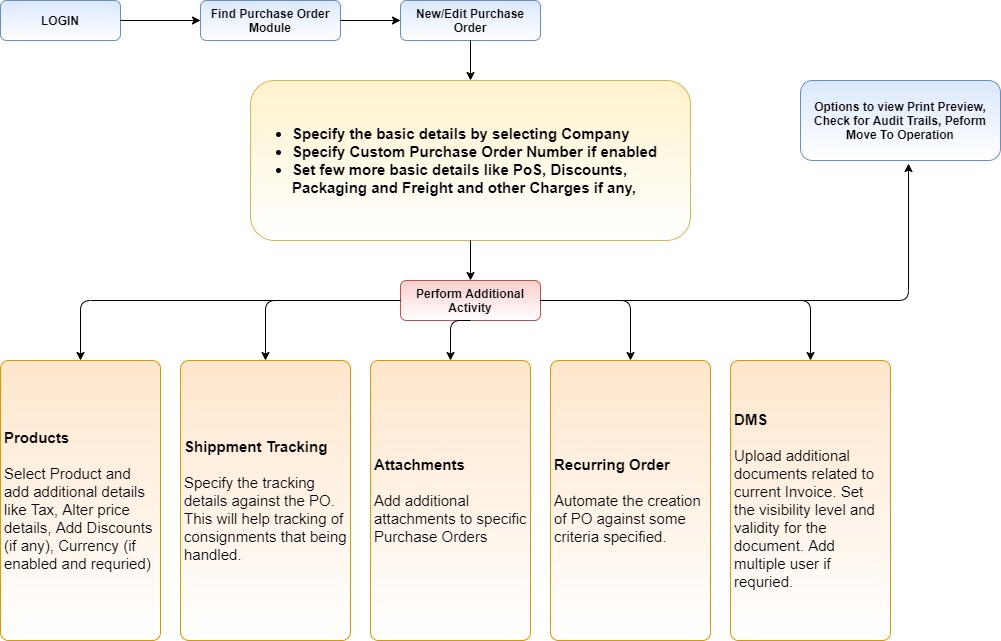
A Purchase order (PO) is a commercial document and first official offer issued by a buyer to a seller indicating types, quantities, and agreed prices for products or services. It is used to control the purchasing of products and services from external suppliers. Purchase orders can be an essential part of enterprise resource planning system orders.
Modules included in this module. We haven’t shown Product as it is a default sub-section without which Purchase Order is incomplete

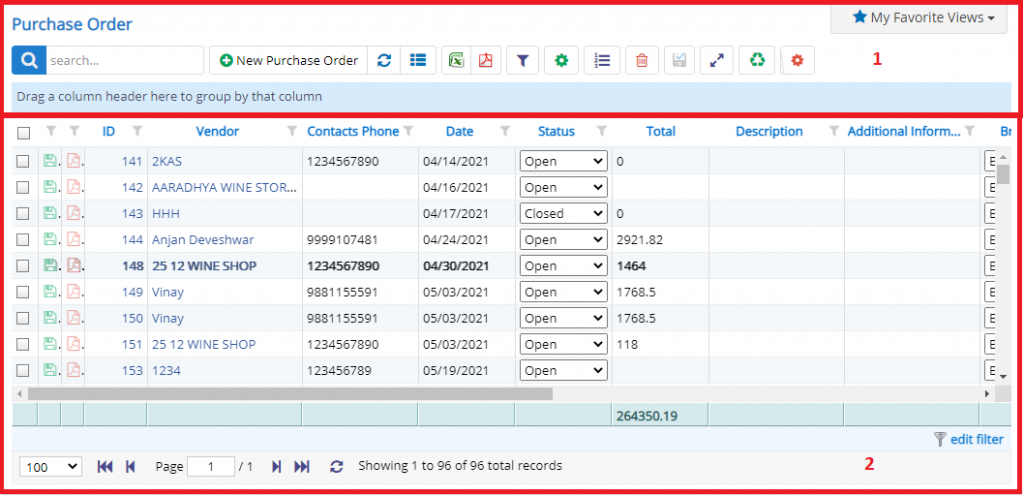
- Annotation – 1 shows few elements like Search, New Purchase Order, Refresh and Column Selector (will describe later in the chapter).
- Search Text box is used to search a specify or similar users form the list below. When you start entering characters it will start searching within the Purchase Order Module.
- Refresh Button is used to reload Purchase Order Grid or Table so that the changes which are made to any user will be reflected on the grid.
- Filters with drop-down feature for the fields like Project, Status, Assigned, etc are few to name. On the other hand, fields which deals with Dates are given two fields as a part of Date range selection. You can use these filters in combination to filter the records.
- Column Selector is used to select one or multiple columns from the range of columns. Following is the image for the Column selector. Note – The columns shown in the filter will keep on changing as and when Nafhaa Platform makes changes to the module.

- Annotation – 2 shows the list of all the PO records that have been created where the user can click record to open it and edit it if needed.
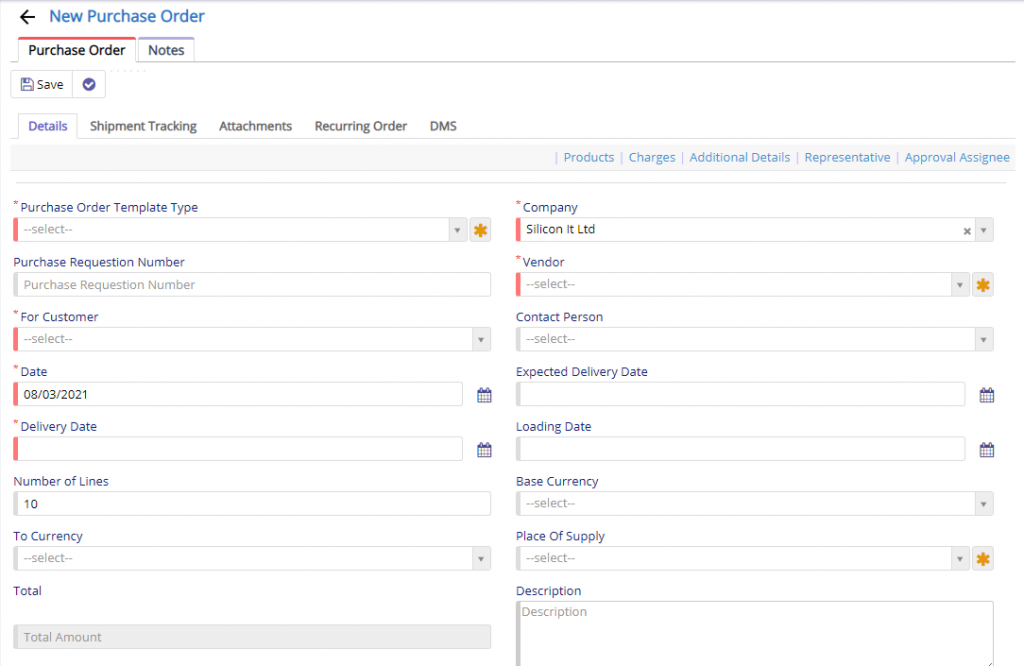
- Project field will be visible only if it is enabled in Company Details Page.
- Company field will be visible only if you have opted for Multi-Company and it is enabled on Company Details page and in that it is enabled for Purchase Order Module.
- Purchase Requisition No field is used specify the Purchase Requisition number if the Purchase is generated via Purchase Requisition module if not then you can safely skip the same.
- Name field is where you will select the Contact/Vendor to whom the Purchase Order will be addressed.
- Date, Expected Delivery Date and Loading Date are used to specify the date of Purchase Order, Expected Delivery Date which will denote the delivery of the product and Loading Date will carry the date when the products will be loaded. Of these two fields Date is compulsory and other two is non-mandatory field.
- No of Lines field will used to add the number of lines in the PDF print. Default is set to 10 that means 10 lines will be added to table.
- Place of Supply will be set from the Contact/Vendor’s location ie. State.
- Lot Details and Description will be used to specify the details for the Purchase Order.
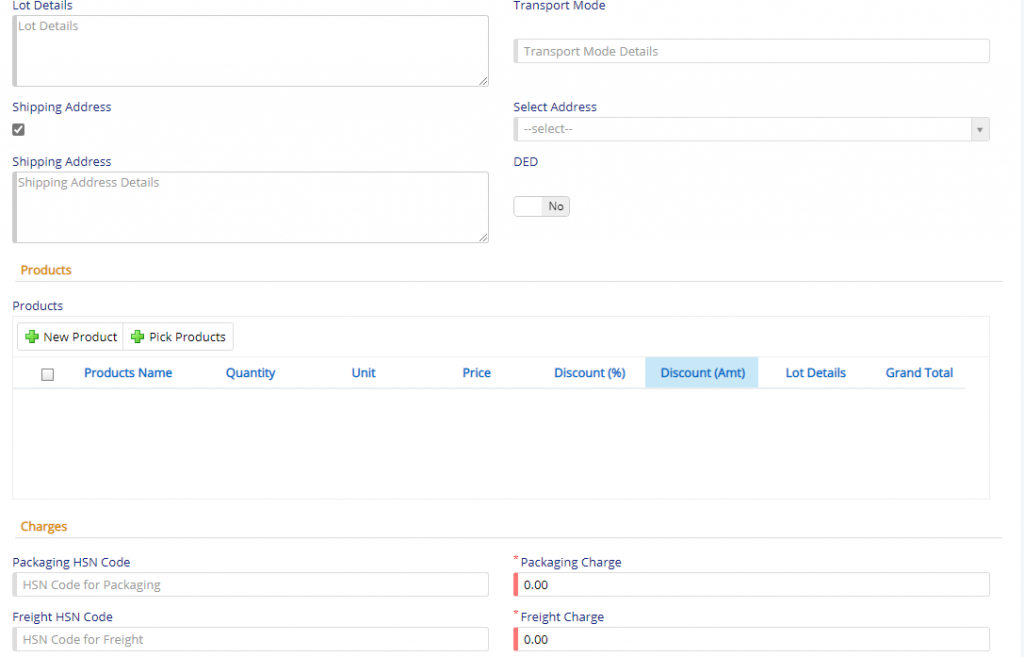
- Shipping address when enabled will show you a Shipping Address field where you can specify the address other than Primary address.
- Packaging HSN Code and Packaging Charges will allow you to specify its code and the amount for the same. Make sure values are proper as it will affect the final amount with GST.
- Freight HSN Code and Packaging Charges will allow you to specify its code and the amount for the same. Make sure values are proper as it will affect the final amount with GST.
- Product field will show you the list of products and when you click the New Product button following window
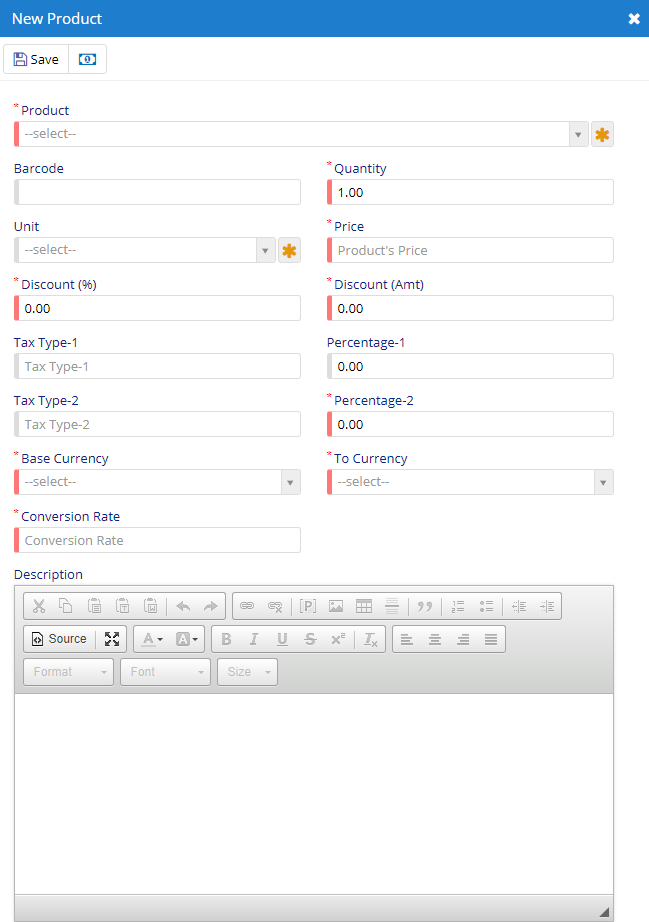
- Here, you have to select the Product and rest all the fields will be auto populated except few of them which you need to change if it is required.
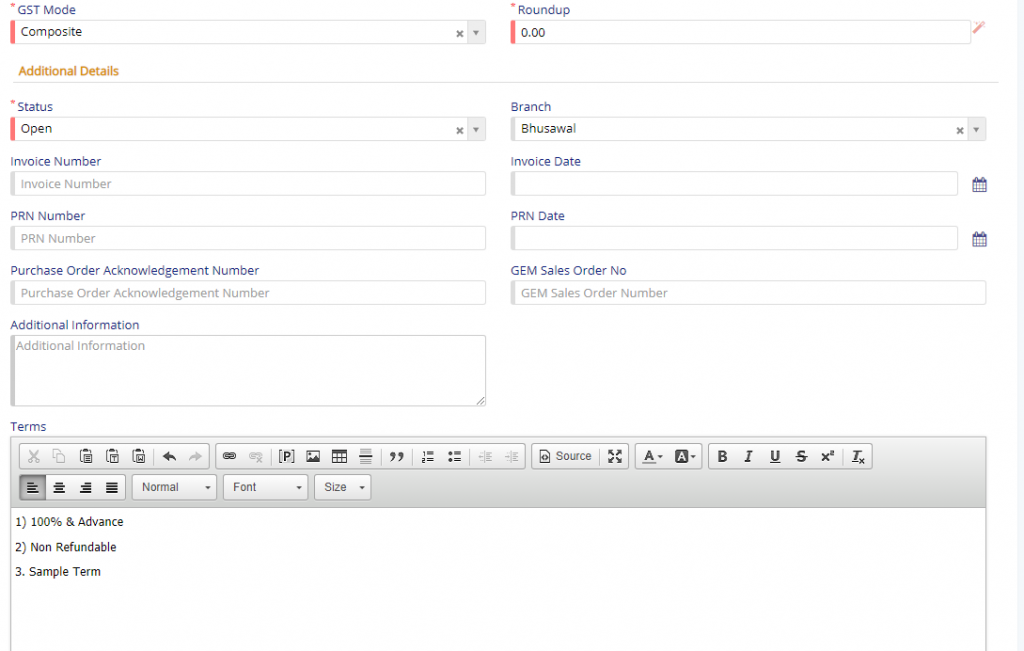
- GST Mode will allow you to select the mode of GST that is applicable for the Purchase Order. There are two possible modes – Mixed and Composite.
- Round-up field will allow you to set the round-up value for the Purchase Order amount.
- Status will allow you to set the Status of Purchase Order. Possible values are – Open, Close, Pending, Parked, Expired.
- Branch will be used to set the branch for the Purchase Order.
- PO Acknowledgement and Additional Info will be used to specify the PO details and other additional information regarding the Purchase Order.
- Terms will allow you to add Terms which are essential for Purchase Order to be valid.
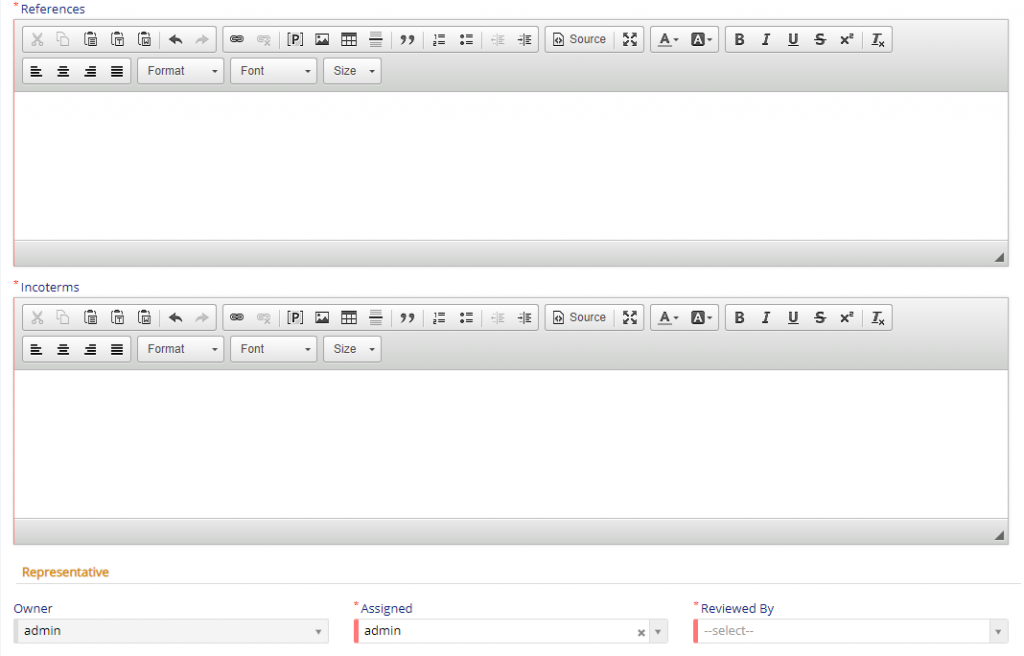
- Owner and Assigned will represent the Owner and Assigned person who has handled it

Here in this Tab, you can add the information for Shipment which is also called as Shipment Tracking. This will list all the points where hands were changed regarding the consignment. To add new Tracking Detail, click the New Tacking button and you will get the following window.

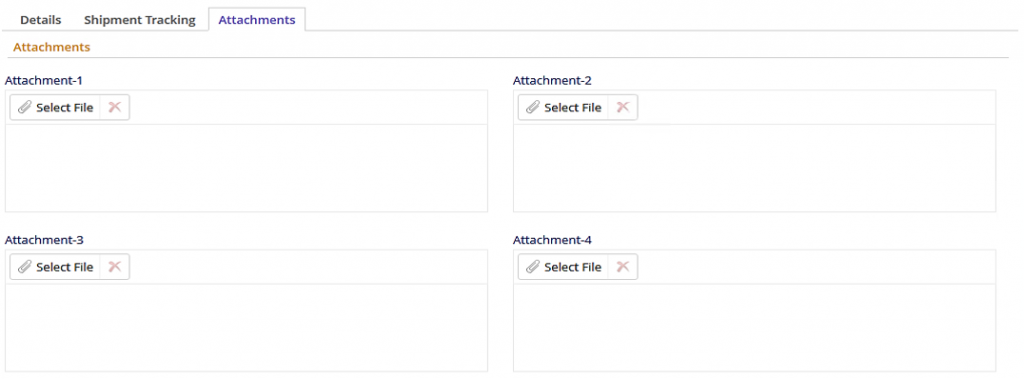
Attachment tab allows you to add documents related to the purchase order. Files can be of any type.
Recurring Order
Recurring Order tab will allow you the user to set the records as recurring based on the frequency specified.

Recurring order tab is visible when required settings are enabled.
- Enable Recurring switch will allow the user to enable the recurring mode for current records which is in process.
- Frequency Value will allow the user to specify the duration after which the records is to be re-created.
- Frequency Type is allow the user to specify the type for the value specified.
- Is Automated flag is set by the system to identify the records which is to be automated.
DMS Tab will allow the user to add documents related to the Purchase Order.
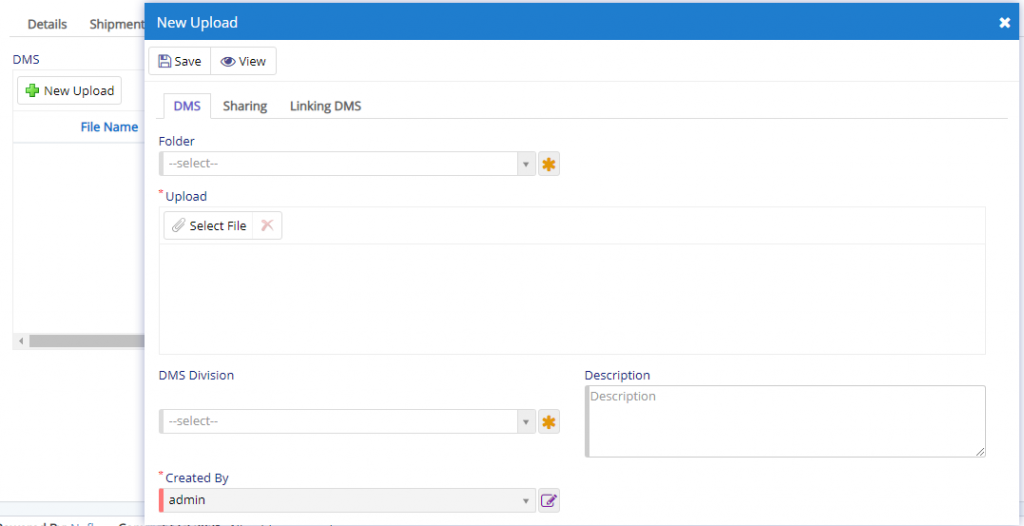
Here, can upload the file, assign Folder level under which it should be uploaded. If more bifurcation is needed, then, one can use DMS Division field. Description field can be used to describe the file in more informative way.
Under DMS, Sharing Tab will be used to share the document to the pears or users with validity specified.

As shown here, the user can select multiple users with whom the file is to be shared. Validity field will put restriction on visibility of the file until the specified date has been elapsed.
Under DMS, Linking Tab can be used to link the DMS to current record.


- Starting from the left is the Update button which is used to Save the changes that you have performed. This button will change to Save when you are Creating an Entry.
- The Next button which is similar to Update button but the only difference is that, it performs the Update operation and remains on the same page. But the later Updates and returns to the Grid displaying List of Purchase Order. It will be called as Apply changes.
- The Next button is for Delete, this will delete the selected record from the database.
- The Preview button will show you the PDF format for the current PO that is open so you will be able to look how your PO looks before sending it to the Vendor/Client.


- Purchase – Purchase Order will be moved to Purchase module for further processing of purchasing the items.
- GRN – Purchase Order will be moved to GRN module for further processing.
- Compare with Purchase – This will compare the Purchase Order products with Purchase entry and provide information regarding the purchases done.
- Compare with GRN – This will compare the Purchase Order product with GRN entry and provide information regarding the progress.


- Send via Mail – An email will be sent to the selected customer using registered Email ID if present in Contacts Master.
- Audit Trails – User can view the modifications done to the Purchase Order record.



- Import Product will provide user a feature to upload multiple product using an excel file in one-go.
- Cashbook Payment Entry will invoke a window of Cashbook module where you can add relevant details of Payments made/received against the Purchase Order or any other Invoices.
Generalized flow of Purchase Order Module
